Bartending is an art that combines history, creativity, and precision, evolving from ancient mixology to modern craft. It balances flavors, techniques, and presentation, requiring skill and flair to create memorable cocktails while engaging customers.
1.1. The History of Bartending
Bartending traces its origins to ancient civilizations, where mixology first emerged as a form of medicinal and ceremonial practice. Egyptians and Greeks infused herbs and spices into wines, laying the groundwork for future cocktail creation. The art evolved through the Middle Ages, with monks experimenting with spirits and botanicals. By the 17th and 18th centuries, punches and toddies became popular, blending spirits with juices and spices. The 19th century marked the birth of modern bartending, with the term “cocktail” gaining popularity and figures like Jerry Thomas pioneering standardized recipes and techniques. Prohibition in the 20th century challenged bartenders, leading to the rise of speakeasies and creative mixology. Today, bartending is a global art form, blending tradition with innovation, emphasizing fresh ingredients, and celebrating the craft of cocktail creation.
1.2. Basic Bartending Terminology
Understanding basic bartending terms is essential for any aspiring mixologist. “Neat” refers to a spirit served without mixers or dilution. “On the rocks” means a drink served over ice, while “straight up” indicates a cocktail strained into a chilled glass without ice. “Shaken” involves mixing ingredients with ice using a shaker, creating a frothy texture, whereas “stirred” blends ingredients gently, preserving clarity. “Muddled” describes crushing fruits or herbs in a shaker to release flavors. A “jigger” is a measuring tool for precise pours, typically in 1 or 2 ounce increments. “Garnish” refers to decorative additions like citrus wheels or olives, enhancing both appearance and aroma. “Dilution” occurs naturally when ice melts, softening a drink’s strength. “Base spirit” is the primary alcohol in a cocktail, such as vodka or rum, forming the flavor foundation. Mastery of these terms enhances communication and efficiency behind the bar, ensuring consistent and quality drinks.
1.3. Importance of Bartending in the Hospitality Industry
Bartending plays a pivotal role in the hospitality industry, elevating customer experiences and driving revenue. Skilled bartenders create unique, handcrafted cocktails that set establishments apart, fostering a loyal clientele. Their ability to engage guests, offer personalized recommendations, and deliver exceptional service enhances overall satisfaction. Bartenders are often the first point of contact, shaping initial impressions and setting the tone for a memorable visit. Additionally, well-designed cocktail menus can significantly boost sales, attracting diverse customer bases. The art of bartending also reflects cultural and culinary trends, making it a dynamic contributor to the industry’s evolution. By balancing creativity, technique, and interpersonal skills, bartenders not only craft drinks but build connections, ensuring a welcoming and enjoyable atmosphere for patrons. Their role is integral to the success and reputation of bars, restaurants, and hotels, making them indispensable in the hospitality landscape.
Essential Tools and Equipment
Bartenders rely on shakers, jiggers, muddlers, bar spoons, and strainers to craft precise, creative cocktails. These tools ensure consistency, quality, and presentation, forming the backbone of professional bartending and elevating the mixology experience.
2.1. Cocktail Shakers: Boston and Cobbler
Cocktail shakers are indispensable tools in bartending, with the Boston and Cobbler styles being the most popular. The Boston shaker consists of two separate parts: a metal bottom and a glass top, allowing for easy separation after shaking. It’s favored by professionals for its durability and versatility. The Cobbler shaker, on the other hand, features a built-in strainer and is more user-friendly, making it ideal for beginners. Both shakers are used to mix, chill, and dilute ingredients, ensuring a balanced flavor profile. When using a Boston shaker, a Hawthorne strainer is often employed to strain the cocktail, while the Cobbler’s built-in strainer simplifies the process. Proper technique, such as gripping the shaker firmly and shaking vigorously, is essential for achieving the desired consistency and texture. Regular cleaning and maintenance of the shakers are also crucial to prevent contamination and ensure optimal performance.
2.2. Jiggers and Measuring Tools
Jiggers and measuring tools are essential for precise cocktail preparation, ensuring consistency and balance in every drink. A jigger typically consists of two chambers, allowing bartenders to measure 1 oz and 2 oz pours accurately. This dual measurement is crucial for maintaining the integrity of classic recipes. Other measuring tools include graduated cylinders and digital scales, which are particularly useful for more intricate mixtures. Accurate measurements prevent over-pouring or under-pouring, which can alter the flavor profile of a cocktail. For instance, using a jigger ensures that the ratio of spirits to mixers remains consistent, preserving the intended taste. Additionally, measuring tools are vital for creating layered drinks and ensuring even distribution of ingredients. Regular calibration of these tools is necessary to maintain precision. By relying on jiggers and measuring tools, bartenders can deliver high-quality cocktails with reliability and professionalism.
2.3. Muddlers, Bar Spoons, and Hawthorne Strainers
Muddlers, bar spoons, and Hawthorne strainers are indispensable tools in bartending, each serving unique purposes to enhance cocktail preparation. A muddler is used to gently crush fruits, herbs, and spices in the shaker, releasing their flavors and oils without pulverizing them. This technique is fundamental for drinks like mojitos and old fashioneds. Bar spoons, typically long and slender, are multi-functional, used for mixing, layering drinks, and measuring small quantities of ingredients. They also aid in muddling when precision is required. Hawthorne strainers, with their spring-loaded design, are essential for filtering ice and solids while pouring shaken cocktails, ensuring a smooth and clean presentation. Together, these tools contribute to the precision and artistry of bartending, allowing for consistent flavor extraction and visually appealing results. Their proper use is a hallmark of professional bartending, elevating both the quality and aesthetics of crafted cocktails.
Spirits and Ingredients
Spirits form the backbone of cocktails, with base options like vodka, rum, tequila, gin, and whiskey. Liqueurs, aperitifs, and bitters add depth, while mixers, juices, and syrups balance flavors, creating harmonious blends.
3.1. Understanding Base Spirits: Vodka, Rum, Tequila, Gin, and Whiskey
Base spirits are the foundation of most cocktails, each offering unique flavor profiles. Vodka, known for its neutrality, pairs well in clear, crisp drinks like the Cosmopolitan. Rum, with its sweet, tropical notes, is central to Daiquiris and Mojitos. Tequila, bold and earthy, shines in Margaritas and Palomas. Gin, aromatic with botanicals, defines classics like the Martini and Negroni. Whiskey, rich and complex, is the star of Old Fashioneds and Manhattans. Understanding these spirits’ origins and flavor profiles is key to crafting balanced cocktails, as their distinct characteristics shape the final drink’s identity and appeal. This knowledge helps bartenders select the right spirit for each recipe, ensuring harmony in every mix.
3.2. Liqueurs, Aperitifs, and Bitters
Liqueurs, aperitifs, and bitters are essential components in mixology, adding depth, complexity, and balance to cocktails. Liqueurs are sweet, flavorful spirits made from fruits, herbs, or other ingredients, often used to enhance sweetness and character. Examples include Triple Sec, used in Margaritas, and Kahlúa, a staple in Espresso Martinis. Aperitifs, such as Campari and Aperol, are dry, slightly bitter spirits enjoyed before meals to stimulate appetite and frequently featured in Negronis and Spritzes. Bitters, made from botanicals like orange peel or gentian, are concentrated flavorings added in small dashes to balance sweetness and harmony in drinks like Old Fashioneds and Manhattans. These ingredients are vital for creating nuanced, well-rounded cocktails, making them indispensable in any bartender’s toolkit. Their versatility allows for endless experimentation, ensuring each drink is uniquely crafted to delight the palate.

3.3. Mixers and Soft Drinks
Mixers and soft drinks are versatile ingredients that enhance cocktails by adding flavor, texture, and length. Tonic water, soda water, and cola are popular mixers that complement spirits like gin and rum, creating refreshing drinks. Tonic water, for instance, pairs perfectly with gin in a Gin & Tonic, while cola is a classic match for rum in a Cuba Libre. Soft drinks like ginger beer and lemon-lime soda add zesty, fizzy elements to cocktails such as the Dark ‘N’ Stormy and Rum & Coke. Fruit juices, including orange, pineapple, and cranberry, are widely used to add sweetness and acidity, as seen in iconic drinks like the Tequila Sunrise and Piña Colada. These mixers not only balance flavors but also allow bartenders to craft lighter, more approachable cocktails. Their quality and freshness are crucial, as they directly impact the overall taste of the drink. Proper storage and chilling ensure optimal results, making mixers indispensable in modern mixology.
3.4. Fresh Fruits, Juices, and Syrups

Fresh fruits, juices, and syrups are essential components in cocktail crafting, offering natural flavors and vibrant colors. Fresh fruits like lemons, limes, oranges, and berries are commonly used for their juices and zests, adding acidity and aroma to drinks like margaritas and mojitos. Juices, such as pineapple and cranberry, provide sweetness and depth, while syrups—made from fruits, herbs, or spices—enhance flavors without overpowering them. Simple syrup, for instance, is a versatile sweetener used in daiquiris and Old Fashioneds. Fresh ingredients ensure authenticity and quality, making them indispensable in modern mixology. Proper storage and preparation are crucial to maintain freshness and flavor, elevating both classic and contemporary cocktails to new heights.
Mixing Techniques
Mixing techniques are fundamental to crafting balanced cocktails. Methods like muddling, shaking, and stirring ensure flavors meld perfectly, while dilution and texture enhancement create a refined drinking experience for any cocktail creation.
4.1. The Art of Muddling
Muddling is a cornerstone technique in mixology that involves gently pressing ingredients to release their flavors and oils. Typically used with fruits, herbs, and spices, it enhances the aroma and taste of cocktails without pulverizing the ingredients. This method is essential in drinks like the Mojito and Old Fashioned, where muddling citrus peels or mint leaves adds depth and complexity. Proper muddling requires a delicate touch to avoid over-extraction, which can lead to bitterness. The right tools, such as a wooden muddler, are crucial for this process. Mastering muddling ensures a balanced and flavorful foundation for various cocktails, making it a skill every bartender should refine.
4.2. Shaking Techniques: Dry Shake, Hard Shake, and Soft Shake
Shaking is a fundamental bartending technique that enhances flavor, texture, and temperature in cocktails. A Dry Shake involves shaking ingredients without ice to emulsify and incorporate air, commonly used for frothy drinks like Whiskey Sours. The Hard Shake, more vigorous, mixes and chills ingredients with ice, ideal for most cocktails to ensure even blending and dilution. Conversely, a Soft Shake is gentle, preserving delicate ingredients like fresh fruits or herbs, preventing bruising or over-dilution. Each technique requires precision to achieve the desired consistency and flavor profile, making them essential skills for bartenders to master for crafting exceptional cocktails.
4.3. Stirring: The Technique for Clear Cocktails
Stirring is a refined method used to mix and chill clear cocktails, preserving their transparency while preventing over-dilution. Typically employed for spirits-forward drinks like the Martini or Negroni, stirring involves gentle agitation with a bar spoon in a mixing glass filled with ice. The process ensures even distribution of flavors and precise temperature control, crucial for maintaining the cocktail’s clarity and balance. Unlike shaking, stirring avoids introducing air, making it ideal for ingredients that should remain unemulsified, such as gin or whiskey. Proper stirring technique requires a steady hand and careful timing, usually around 30–40 seconds, to achieve the perfect chill without diluting the drink excessively. This method is fundamental for bartenders to deliver crisp, sophisticated cocktails that highlight the purity of their ingredients.

Classic and Popular Cocktails
From timeless classics like the Old Fashioned to vibrant favorites like the Mojito, these iconic drinks showcase the art of bartending, blending flavors and techniques that have captivated audiences for generations worldwide.
5.1. Old Fashioned, Negroni, and Martini
The Old Fashioned, Negroni, and Martini are cornerstones of classic mixology, each with a rich history and distinct flavor profile. The Old Fashioned, dating back to the 19th century, is a robust blend of bourbon or rye whiskey, sugar, bitters, and a citrus twist, embodying simplicity and depth. In contrast, the Negroni, created in the early 20th century, is a bitter yet balanced mix of gin, Campari, and sweet vermouth, served with an orange garnish, offering a bold, sophisticated taste. The Martini, iconic and versatile, typically features gin and dry vermouth, often garnished with an olive or lemon twist. Its evolution includes variations like the Vodka Martini, showcasing adaptability while maintaining elegance. These cocktails are celebrated for their timeless appeal and are considered essential for any bartender’s repertoire, representing the art of balancing flavors and techniques that have captivated audiences for generations.
5.2. Daiquiri, Margarita, and Mojito
The Daiquiri, Margarita, and Mojito are vibrant, flavorful cocktails that have become staples in modern mixology. The Daiquiri, originating in Cuba, is a simple yet elegant blend of white rum, fresh lime juice, and simple syrup, often served frozen for a refreshing twist. Its clean, citrusy profile makes it a timeless favorite. The Margarita, a classic tequila-based cocktail, combines tequila, triple sec, and lime juice, typically served in a salt-rimmed glass. Its bold, zesty flavors have made it a crowd-pleaser. The Mojito, another Cuban gem, features white rum, lime juice, mint leaves, and soda water, offering a refreshing, herbaceous taste. These cocktails are not only popular but also versatile, with variations that cater to different preferences. They are essential additions to any bartender’s repertoire, showcasing the balance of citrus, sweetness, and spirit that defines modern cocktail culture.
5.3. Cosmopolitan, Mai Tai, and Pina Colada
The Cosmopolitan, Mai Tai, and Pina Colada are iconic cocktails that have captivated drinkers worldwide with their unique flavors and vibrant presentations. The Cosmopolitan, made with vodka, triple sec, cranberry juice, and lime, is a modern classic known for its fruity and sophisticated profile, often associated with urban nightlife. The Mai Tai, a tropical blend of rum, lime, orange curaçao, and orgeat syrup, boasts a rich history and a delicate balance of tangy and sweet notes. The Pina Colada, combining rum, pineapple juice, and coconut cream, is a creamy, tropical escape perfect for warm weather. These cocktails are not only crowd-pleasers but also showcase the versatility of rum and vodka in crafting diverse flavor experiences. Their popularity endures due to their refreshing, indulgent qualities, making them must-have additions to any bartender’s menu.

5.4. Modern Twists on Classic Cocktails
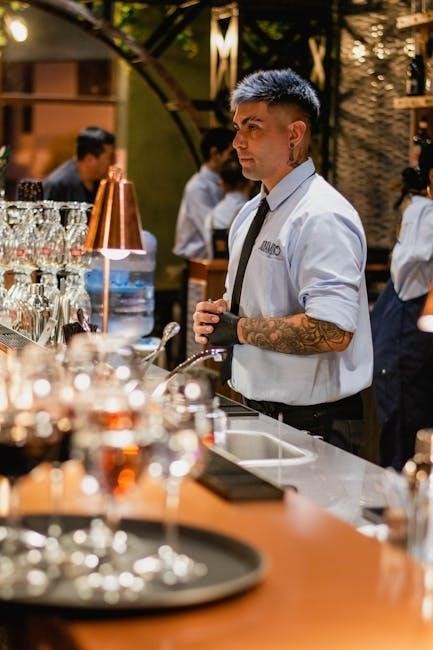
Modern twists on classic cocktails breathe new life into timeless recipes, offering innovative flavor profiles while honoring their origins. Bartenders now experiment with unique spirits, house-made infusions, and unconventional ingredients to reimagine iconic drinks. For instance, the Old Fashioned might feature smoky notes from mezcal or barrel-aged bitters, while the Negroni could incorporate floral gin or yuzu for a citrusy twist. Techniques like fat-washing, molecular mixology, and fermentation are also being employed to elevate classics. These creative interpretations not only cater to evolving palates but also showcase a bartender’s ingenuity. By blending tradition with innovation, modern twists ensure that classic cocktails remain relevant in an ever-changing culinary landscape, appealing to both purists and adventurous drinkers alike. This approach keeps the art of bartending dynamic and exciting, proving that even the most established recipes can evolve with the times.
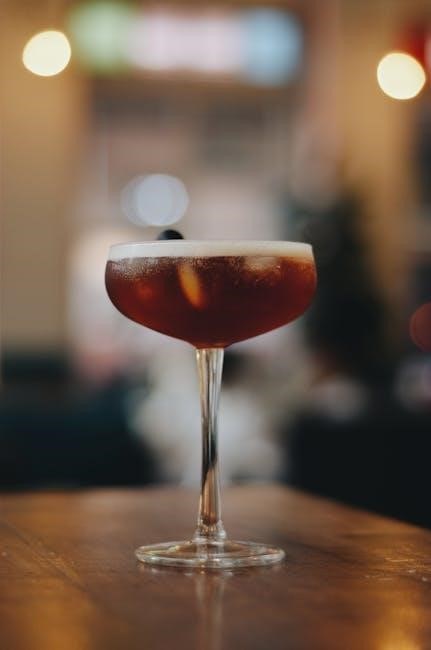
Garnishing and Presentation
Garnishing enhances cocktails with visual appeal, using wheels, wedges, or skewers. Proper glassware selection and artistic presentation elevate the drink’s professionalism and aesthetic, making it a delightful experience for the senses.
6.1. The Art of Garnishing: Wheels, Wedges, and Skewers
Garnishing is a cornerstone of bartending, transforming cocktails into visually appealing creations. Wheels, wedges, and skewers are essential techniques for adding fresh fruits, herbs, or olives to drinks. A lemon or orange wheel, cut thinly and placed on the rim of a glass, adds a burst of citrus flavor and elegance. Wedges, such as lime or orange, are often used in classic cocktails like margaritas or whiskey sours, providing both aesthetics and functionality. Skewers, meanwhile, allow bartenders to combine multiple garnishes, such as cherries and oranges, creating a colorful and intricate presentation. Proper knife skills are crucial for precision cutting, ensuring garnishes are both visually appealing and safe to consume. The choice of garnish not only enhances the drink’s aroma and flavor but also reflects the bartender’s creativity and attention to detail, making it a key element in the overall cocktail experience.
6.2. Glassware: Choosing the Right Glass for Each Cocktail
Selecting the appropriate glassware is vital for enhancing the cocktail experience. Each glass is designed to complement specific drinks, ensuring optimal aroma, flavor, and visual appeal. Highball glasses, tall and slender, are ideal for mixed drinks like mojitos or gin and tonic, allowing ice to stay intact. Old Fashioned glasses, with their sturdy design, are perfect for whiskey-based cocktails, preserving the drink’s temperature. Martini glasses, iconic and conical, are tailored for clear, chilled cocktails like martinis or cosmopolitans, emphasizing clarity and aroma. Coupe glasses, similar to martinis but with a curved bowl, are great for frothy drinks like daiquiris. Margarita glasses, with their salt-rimmed edges, are designed specifically for margaritas, while Hurricane glasses, taller and wider, suit tropical drinks like piña coladas. Choosing the right glass enhances the drink’s presentation and enjoyment, making it a key element in bartending craftsmanship.
6.3. Garnish Preparation and Storage
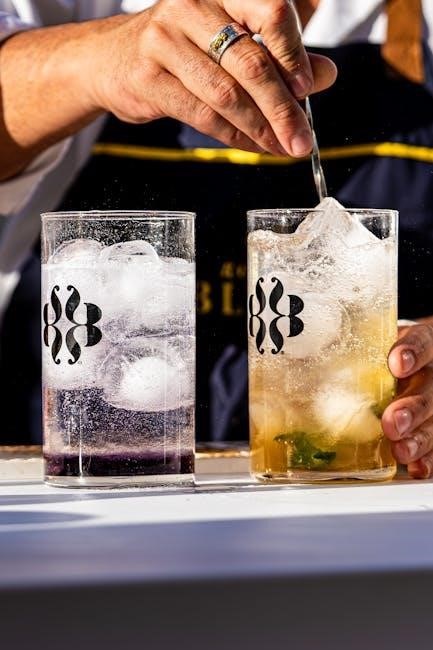
Garnishes are essential for elevating cocktails, adding both visual appeal and flavor. Proper preparation and storage ensure freshness and longevity. Common garnishes include citrus wheels, wedges, olives, cherries, and fresh herbs like mint or rosemary. For citrus, use a sharp knife to slice thinly, avoiding seeds, and store in airtight containers in the refrigerator. Olives and cherries should be stored in their brine or syrup to maintain flavor and texture. Fresh herbs can be stored in damp paper towels or ice cube trays with oil for extended use. Always use fresh, ripe ingredients for the best results. Muddlers and skewers are handy tools for handling garnishes without bruising them. Keep garnishes organized in a designated area, such as a chilled garnish tray, to streamline service. Proper storage prevents spoilage and ensures garnishes remain vibrant and flavorful, enhancing the overall cocktail experience.
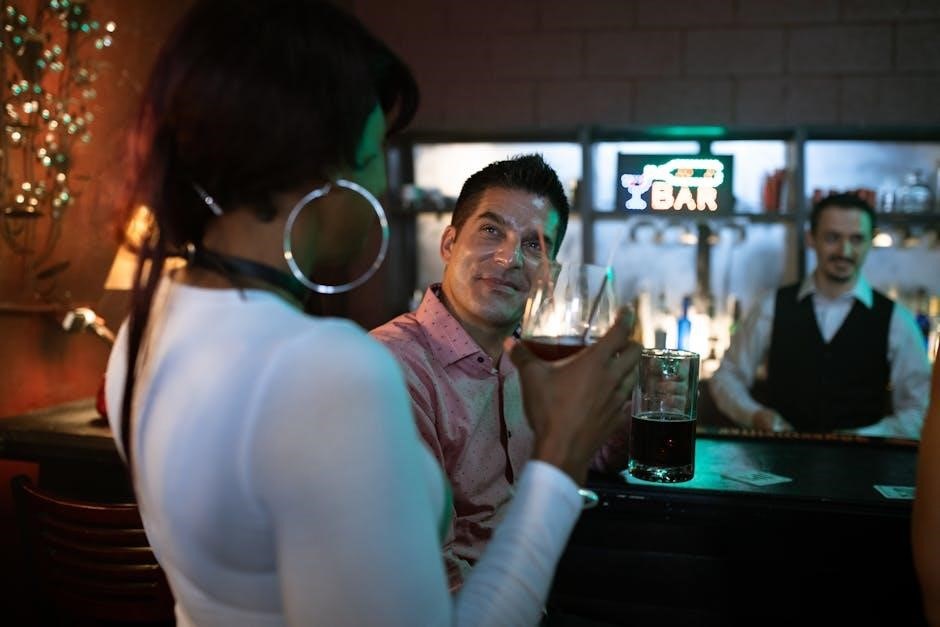
Customer Interaction and Service
Mastering customer interaction is crucial for bartenders, involving active listening, attentiveness, and adaptability. Personalizing drinks, handling requests with grace, and creating a welcoming atmosphere fosters satisfaction and loyalty, enhancing the overall experience.
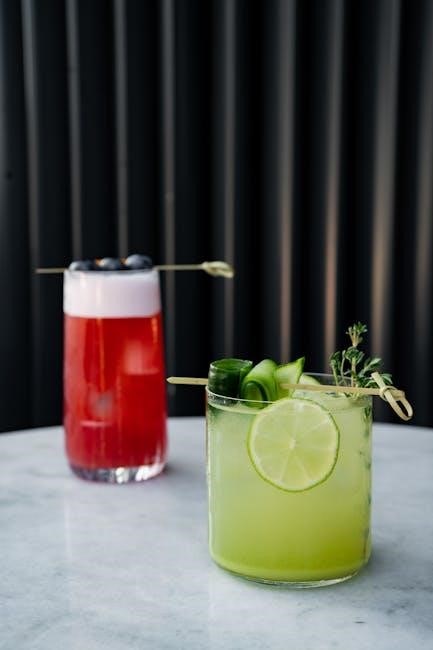
7.1. Building Rapport with Customers
Building rapport with customers is essential for bartenders to create a positive and memorable experience. By actively listening, engaging in friendly conversations, and personalizing interactions, bartenders establish trust and connection. This fosters customer satisfaction, encouraging repeat visits and positive reviews.
7.2. Handling Special Requests and Complaints
Handling special requests and complaints is a critical skill for bartenders to ensure customer satisfaction. Always listen actively, remain calm, and address concerns politely. For special requests, such as stronger drinks or modifications, explain your approach clearly. If a complaint arises, acknowledge the issue, apologize sincerely, and offer a solution. Stay professional and avoid taking feedback personally. By maintaining a positive attitude and showing empathy, you can turn a negative experience into a positive one. If necessary, involve a manager to resolve the situation. Remember, customer satisfaction is key to building loyalty and a good reputation for your bar. Effective communication and problem-solving skills are essential in these moments. Always aim to exceed expectations and ensure every patron leaves happy and satisfied with their experience.
